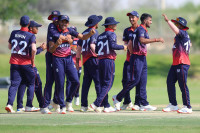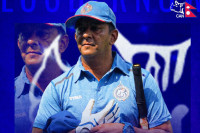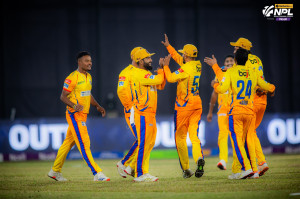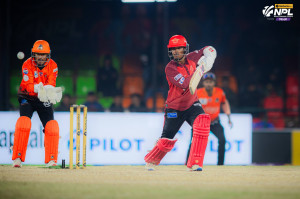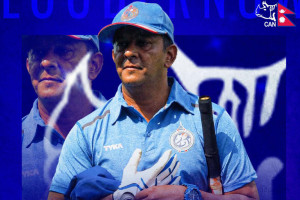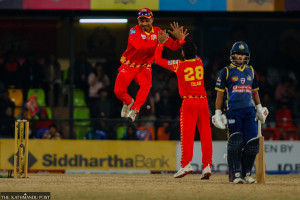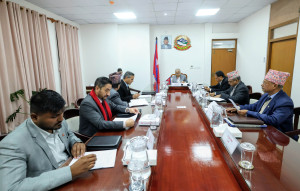Sports
Nepal closes towards consecutive participation at T20 World Cup
The Rhinos scraped past the UAE and Qatar in two of their narrowest T20I wins ever—results that keep them in the hunt. But Stuart Law’s quest to shed the ‘cardiac kids’ tag is far from over.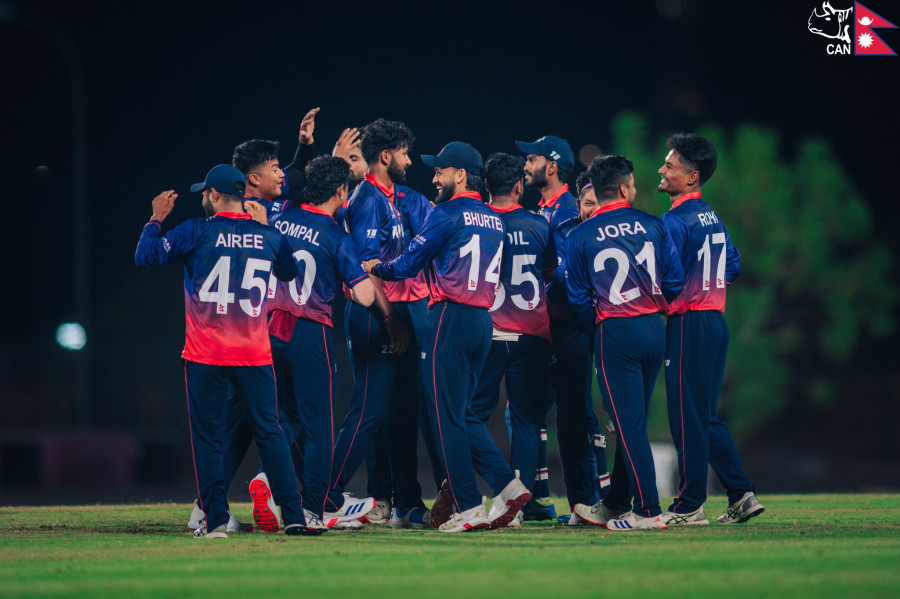
Post Report
Among the nine countries participating in the Asia & EAP Qualifier, Nepal were the team that entered with the highest confidence. The reason: the Rhinos had just defeated two-time T20 World Cup winners, the West Indies, 2-1 to clinch a three-match T20I series.
Further, two in two wins in the warm-up matches of the Qualifier—a 6-wicket win over Oman on October 4 and a 16-run win over Qatar on October 6—boosted their morale as a high-stake tournament kicked off on October 8.
Facing Kuwait in the first group-stage game on October 8, Nepal kicked off well with a 58-run victory. It was Nepal’s third win against Kuwait in four encounters.
However, when Nepal faced Japan, an emerging Associate, in the other game of the group-stage on October 10, it was not easy. Despite winning by five wickets, Nepal struggled against Japan, a team alongside which the Rhinos played their first international cricket tournament through the first edition of the ACC Trophy in 1996.
The two group-stage wins propelled Nepal to the Super 6 with two points.
Two teams from each of the three groups in the Qualifier entered the Super 6. Out of the two teams progressing to the Super 6, the one that had defeated the other in the group-stage would carry two points with them to the next stage.
Thus, since Nepal had defeated Japan, the other team that entered the Super 6 with Nepal from Group A, in the group, they had two points to start.
Of the nine teams divided into three groups of three each in the Qualifier, the top two teams from each group progressed to the Super 6. Of the six teams, the top three teams will play in the 2026 T20 World Cup being co-hosted by India and Sri Lanka.
Heart stopping moments in Super 6
The top two teams from each group are playing four other teams from other groups in the Super 6. Therefore, Nepal played the UAE and Qatar of Group A on Sunday and Monday, respectively.
Nepal needed wins in every game in the Super 6 to cement their chances to play in consecutive T20 World Cups. Debuting in the T20 main event in 2014, the Rhinos waited a decade to march into the World Cup last year. If they manage to finish the Qualifier as one of the top three teams, it will be the first time that Nepal will play in consecutive World Cups.
Nepal have managed two wins in two matches in the Super 6, but they were troubling ones for the fans.
In the match against the UAE on Sunday, Nepal posted the target of 141 runs. In turn, the UAE took the chase to the final ball, but fell short of one run as they were chasing 10 runs in the final over, which was a thriller with Nepali fans, at one time, losing all the hopes.
A similar scenario repeated against Qatar, a team with a majority of players who work 12-hours a day except playing cricket, on Monday.
Qatar, who were chasing Nepal’s decent target of 149 runs, lost their first wicket—Imal Liyanage departed at 56 off 35—in the last ball of the 10th over with the team’s score at 79 runs.
The batting was going well for Qatar as Zubair Ali and Muhammad Asim, who departed as the second wicket after contributing 10 off 5, took the score to 97 runs at the end of the 12th over.
Requiring only 51 runs off 42 deliveries, Qatar, with eight wickets remaining, had put pressure on Nepali players and fans alike. A silent parapet of a couple of hundreds of Nepali fans at the Ministry Turf 1 of the Oman Cricket Academy in Al Amerat, alongside hundreds of thousands watching live in front of different screens, however, started finding relief as the Rhinos fought back and sent the remaining eight batters of Qatar back to the pavilion in just 45 runs, and registered a win by five runs.
As the match finished, the Rhinos’ nickname—the Cardiac Kids—started resurfacing at an exponential rate.
Further, the two wins—against the UAE and Qatar—were Nepal’s smallest victories ever in T20Is. The one-run win over the UAE ranks at the top, bettering the 3-run win over Namibia on March 1 last year. Similarly, the 5-run win over Qatar is now the third-smallest T20I victory for Nepal, bettering the 6-run win over Malaysia on July 14, 2019.
Nepal still have two more games remaining in the Super 6—against Oman on Wednesday and Samoa on Friday. Only one win in any of the two matches will ensure Nepal’s berth at the 2026 T20 World Cup. But the fans expect that the team does not make them grab their chest in those two fixtures.
‘Cardiac Kids’ tag
Ahead of the three-match T20I series against the West Indies in Sharjah, Nepal’s head coach Stuart Law shared that he wanted to get rid of the Rhinos’ tag of ‘Cardiac Kids’.
‘Cardiac Kids’ has been a nickname for Nepali cricket for over seven years now. Peter Della Penna, a USA correspondent for Espncricinfo, is credited for christening the nickname. “Nepal have been the specialists of heart-stopping finishes in the WCL Division Two and their victory to seal a place in the World Cup Qualifier was a perfect example,” Penna wrote in the sub-headline of the article ‘The Cardiac Kids from Nepal’ published on February 25, 2018.
Penna had written the article a day after Nepal defeated Canada by 1 run to top the league table and book a place in the final.
“Heart-stopping finishes have become de rigueur with Nepal this week at the WCL Division Two. They opened the tournament with a one-wicket win over Namibia chasing 139. Then, they needed two runs off the last ball to outlast Kenya. Against Canada, with a spot in the World Cup qualifier on the line, they managed to combine the excitement of both those games,” Penna wrote in the article.
Ever since, Nepal have had many instances in international cricket where the fans’ hearts have almost stopped beating. But the Rhinos have also given many moments where the hearts of the Rhino Army started beating better through comebacks.




 8.12°C Kathmandu
8.12°C Kathmandu
